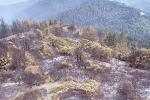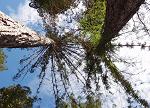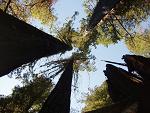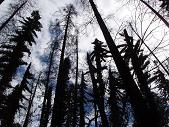|
|
|
^The 1945 Trinidad fire burned west from coastal Sitka spruce forest. [Anon.] |
^The 2003 Canoe fire destablized trees by burning out their basal cavities. |
^Fire enlarged old growth redwood hollows and partially girdled many other ancient trees. |

|

|

|
^The Canoe fire scorched bark and logs on alluvial flats. |
^These shrubs on Grasshopper Peak were top killed, but resprouted. |
^Mortality was high on dry upper slopes as is typical of most fires of the region. [Rocco Fiori, CDPR] |

|

|

|
^Although fire seemed to kill some redwoods, many canopies resprouted during 2004. |
^By October of 2004, canopies were visibly recovering, but canopy cover was reduced overall. |
^This lower slope burned hot, killing the Douglas fir and defoliating the redwood. The "pipe-cleaners" are redwood branches resprouting. |
|
|
|
^A few old growth redwood were girdled and died. Fire burned through this tree's bark to expose the sapwood. |
^It is likely that nearly all old redwood formed thermal wounds at their base. Most scars will heal over within 10 years. |
^One year after the Canoe fire, litter was nearly continuous. A reburn is now possible, consistent with the tree ring record. |
|
|
|
^This large gap formed by a winter storm event in the Arcata Community Forest. |
^Did humid coast redwood burn? Yes, but we still aren't sure how often. |
^Many redwoods sprouted at their base, even when they exhibited little visible damage. |
|
|
|
^A recent blowdown in the Arcata Community Forest. |
^This False Solomon's Seal (Smilacina stellata) thrives after the 2003 Canoe fire. |
^This banana slug glides up a young redwood recently debarked by a bear. Note the white claw marks. |

